
Explore the archetype of the witch from its ancient history to its influence on contemporary feminism and girl culture
Boston is about to host its first ever Butoh festival. It’s a small festival this year—only one weekend’s worth of programming—but a good introduction to Butoh for those who are unfamiliar. Which is almost everyone. And even those who are most familiar with it have difficulty defining it.
Technically, Butoh is a type of dance. But it doesn’t look like most dance because it was developed to resist traditional Western forms like Modern Dance and Ballet.
Butoh emerged in Japan shortly after World War II. Which means that it is tied up with the large collection of experimental art movements that flourished mid-century, and also that it can’t help but be impacted by the American atomic bombings there at the end of the war.
Butoh’s movements are tense, taut, transfixing and often gothic. Though rooted in the gestures of farmers and peasants going about their daily lives, this art form operates like horror films do in comparison to non-horror films. In horror films, a story may begin as any other film does, but a thin layer of normal social behavior quickly dissolves to reveal what we fear most lurking right beneath.
Boston Butoh Festival, a 3-day event including performances and a 2-day workshop, is the brainchild of Sara June, a performance artist affiliated with Boston’s Mobius collective, and also a teacher and practitioner of Butoh. Sara June became interested in Butoh after seeing a solo performance at Pan9, a long-defunct Allston venue, right after completing a BFA in painting in 1999. “The performer seemed to transform herself into a piece of visual art with her achingly slow movements. All the parts of her body, including her face, were activated by what seemed like raw emotion. I was hooked.”
Sara June sees Butoh as a reaction to colonization, “[It was] a response to the invasion of Western art forms in [Japan]. The stereotype of Butoh is of extremely slow-moving performers, painted totally white, with shaved heads. But it is really a very eclectic performance form.” She cites influences that include “physical theater, Noh theater, avant-garde performance of the 1960s and ‘70s, drag and feminist/queer performance,” and adds, “It also has roots in Japanese shamanism and indigenous movement.”
Gemica Rosenberg, a local who will perform at the festival, found her way to Butoh by accident. “After attending California College of the arts and completing my thesis show, I felt like my sculptures were beginning to incorporate sound and teetering on the edge of performance. But I didn’t have that much exposure to performance art”, Rosenberg explains. “When I moved back to Boston, I was looking for a healing experience for mind and body that purely visual art hadn’t been able to give me. I started taking a somatic movement class at Green Street Studios.” When this class ended, she wasn’t ready to stop moving, so tried out a Butoh class. “I didn’t really know what Butoh was exactly”, she admits, “but since then,” she continues, “I’ve begun to integrate my material making with movement and sound.”
For the festival, Rosenberg will “Explore the archetype of the witch from its ancient history to its influence on contemporary feminism and girl culture. I’ve developed my own sound score with samples, synth and field recordings, designed a costume, and choreographed a 10-minute solo.”
The festival also features artists from outside of Boston. Including Yuko Kaseki from Berlin, and Zack Fuller, Emily Smith and Michael Evans from New York City. Sara June selected each because she found their work “boundary-pushing” in a way that is rarely seen in Boston. “It will certainly challenge the more conservative sensibilities here,” she promises.
BOSTON BUTOH FESTIVAL. APRIL 19-21. GREEN STREET STUDIOS, 185 GREEN ST., CAMBRIDGE. LISTINGS AND TICKETS AVAILABLE AT MOBIUS.ORG/EVENTS.
Heather Kapplow is a Boston-based conceptual artist and writer.

